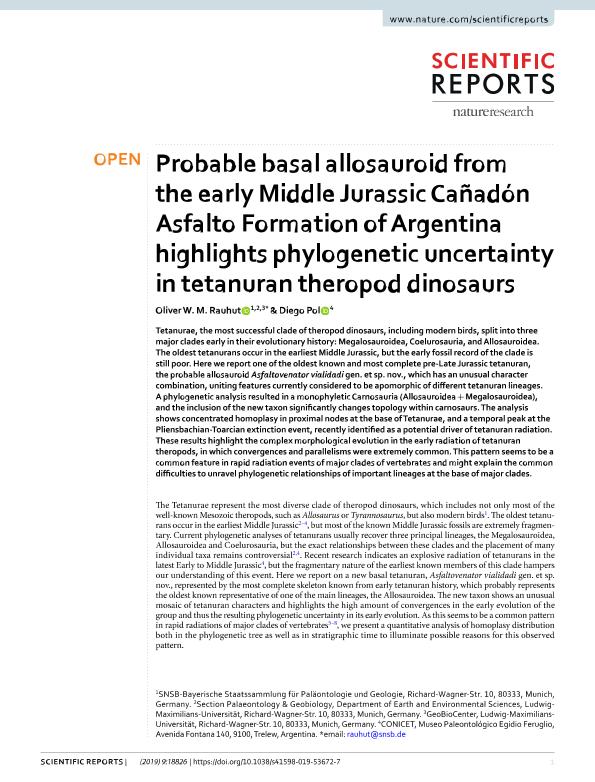Mostrar el registro sencillo del ítem
dc.contributor.author
Rauhut, Oliver Walter Mischa

dc.contributor.author
Pol, Diego

dc.date.available
2022-10-27T15:43:06Z
dc.date.issued
2019-12
dc.identifier.citation
Rauhut, Oliver Walter Mischa; Pol, Diego; Probable basal allosauroid from the early Middle Jurassic Cañadón Asfalto Formation of Argentina highlights phylogenetic uncertainty in tetanuran theropod dinosaurs; Nature Publishing Group; Scientific Reports; 9; 1; 12-2019; 1-9
dc.identifier.uri
http://hdl.handle.net/11336/175207
dc.description.abstract
Tetanurae, the most successful clade of theropod dinosaurs, including modern birds, split into three major clades early in their evolutionary history: Megalosauroidea, Coelurosauria, and Allosauroidea. The oldest tetanurans occur in the earliest Middle Jurassic, but the early fossil record of the clade is still poor. Here we report one of the oldest known and most complete pre-Late Jurassic tetanuran, the probable allosauroid Asfaltovenator vialidadi gen. et sp. nov., which has an unusual character combination, uniting features currently considered to be apomorphic of different tetanuran lineages. A phylogenetic analysis resulted in a monophyletic Carnosauria (Allosauroidea + Megalosauroidea), and the inclusion of the new taxon significantly changes topology within carnosaurs. The analysis shows concentrated homoplasy in proximal nodes at the base of Tetanurae, and a temporal peak at the Pliensbachian-Toarcian extinction event, recently identified as a potential driver of tetanuran radiation. These results highlight the complex morphological evolution in the early radiation of tetanuran theropods, in which convergences and parallelisms were extremely common. This pattern seems to be a common feature in rapid radiation events of major clades of vertebrates and might explain the common difficulties to unravel phylogenetic relationships of important lineages at the base of major clades.
dc.format
application/pdf
dc.language.iso
eng
dc.publisher
Nature Publishing Group

dc.rights
info:eu-repo/semantics/openAccess
dc.rights.uri
https://creativecommons.org/licenses/by/2.5/ar/
dc.subject
Jurassic
dc.subject
Theropoda
dc.subject
Dinosauria
dc.subject
Patagonia
dc.subject.classification
Paleontología

dc.subject.classification
Ciencias de la Tierra y relacionadas con el Medio Ambiente

dc.subject.classification
CIENCIAS NATURALES Y EXACTAS

dc.title
Probable basal allosauroid from the early Middle Jurassic Cañadón Asfalto Formation of Argentina highlights phylogenetic uncertainty in tetanuran theropod dinosaurs
dc.type
info:eu-repo/semantics/article
dc.type
info:ar-repo/semantics/artículo
dc.type
info:eu-repo/semantics/publishedVersion
dc.date.updated
2022-10-27T10:20:51Z
dc.identifier.eissn
2045-2322
dc.journal.volume
9
dc.journal.number
1
dc.journal.pagination
1-9
dc.journal.pais
Reino Unido

dc.journal.ciudad
Londres
dc.description.fil
Fil: Rauhut, Oliver Walter Mischa. Ludwig Maximilians Universitat; Alemania. Bayerische Staatssammlung für Paläontologie und Geologie; Alemania
dc.description.fil
Fil: Pol, Diego. Consejo Nacional de Investigaciones Científicas y Técnicas; Argentina. Museo Paleontológico Egidio Feruglio; Argentina
dc.journal.title
Scientific Reports
dc.relation.alternativeid
info:eu-repo/semantics/altIdentifier/doi/http://dx.doi.org/10.1038/s41598-019-53672-7
dc.relation.alternativeid
info:eu-repo/semantics/altIdentifier/url/https://www.nature.com/articles/s41598-019-53672-7
Archivos asociados
